The best task management software you can currently buy is either ClickUp or Wrike, which both scored highly for task management in our most recent round of project management software testing.
Wrike and ClickUp will provide you with multiple ways to view your tasks, including Kanban boards and Gantt charts, plus features like sub-tasks and time tracking that ensure you’re able to stay organized, no matter how complex your project is. The raft of features they offer means you’ll be able to leave the days of hopping between apps behind and centralize your workplace operations around them – they are complete Work OS programs.
Hot on their heels is monday.com, however, which scores similarly for task management and is our top-rated provider overall – plus, it’s easier to use than ClickUp and Wrike. In this guide:
- The Best Task Management Software: Comparison Table
- What Is Task Management Software?
- The Best Task Management: Test Summary
- The Best Task Management Software: Reviews
- Key Features to Look for in Task Management Software
- About Our Research
- Verdict: Why ClickUp Is the Best Task Management Software
- Frequently Asked Questions
| Price from All prices listed as per user, per month (billed annually) | Gantt Chart | Gantt Chart on Free Plan? | Team View | Kanban board | Sub-Tasks | Task Dependencies | Time Tracking | Unique features | AI capabilities | Free plan highlights | Integration options | ||
|---|---|---|---|---|---|---|---|---|---|---|---|---|---|
| Best Overall | Best for Large Businesses | Easiest to Use | Best Value | Best for Tracking Budgets | |||||||||
| | | | | | |||||||||
| | | | | | |||||||||
| | | | | | |||||||||
| | | | | | |||||||||
| | | | | | |||||||||
| | | | | | |||||||||
| | | | | | |||||||||
| Chat view is a nice differentiator that allows you to create chats for different purposes | Two Enterprise plans, which cater to businesses with exceptionally complex needs | High level of customizability | Excellent time tracking tools | Unlimited storage across all plans, including free | |||||||||
| ClickUp Brain | Work Intelligence | monday AI | Teamwork.com AI assistant | Asana AI | |||||||||
| 100 automations per month | Web, desktop, and mobile apps | Over 200 available templates | 5-user limit | Over 100 free integrations | |||||||||
| Slack, GitHub, HubSpot, Google Drive, and more. | QuickBooks, Miro, Salesforce, Google Sheets, and more | Canva, Sharepoint, Shopify, and more | Slack, Harvest, Xero, and more | Microsoft Teams, Adobe Creative Cloud, Okta, and more |
The Best Task Management Software: Comparison Table
As we’ve covered, the best task management software is ClickUp or Wrike. Overall, the top five are:
ClickUp – the best overall & great for collaboration
Wrike – the best for large companies & organizations
monday.com – the easiest to use software
Teamwork – the most value for the least money
Asana – the best for tracking budgets & displaying project data
Note: All the images used in this article were taken during Tech.co’s project management user testing series. For more information on how we test project management tools, as well as other products, visit our product research page.
What Is Task Management Software?
Task Management Software is any software that facilitates one of the key components of managing a project – managing tasks through their various stages from beginning to end. This includes project management software tools.
Task management software will typically allow you to input all of your project’s tasks, order and organize them, and display them in different ways, helping you understand how they interact with one another.
Task management software tools such as monday.com include features like sub-tasks for splitting up your largest core tasks into smaller components, task dependencies that will illuminate your project’s critical path and features like milestones that mark the most important stages of your project’s life cycle.
Test Summary
I’ve tested 10 major task management software tools and I found ClickUp to be the most capable one when it comes to complex task management. There are so many ways to view all the tasks in your project that you can simply choose the one that’s best for you. I personally prefer the simple list view and the Kanban board because I’m used to it – but not everyone on my team feels the same.
Although not quite as impressive as ClickUp in other aspects, Wrike’s task management tools gave ClickUp a run for their money. I found the time-tracking feature is really easy to use and incredibly useful for breaking down how long different phases of your project will take.
It’s also worth mentioning that monday.com is much simpler to use and I found it less cluttered and intimidating than Wrike and ClickUp – the task management features were easier to access and the general user experience was more welcoming. I felt much more organized after using monday.com.

The Best Task Management Software: Reviews
Here, we’ve put together reviews of the best task management software available. Read on to find out more:
ClickUp
Price From: $7 per user, per month
Best task management software for: Overall functionality
Task management score: 4.7/5
ClickUp is our top-rated task management tool overall, and it’s packed with useful features for managing tasks, even on its cheapest plans.

Pros
- Genuinely impressive free plan
- 15+ ways to view project progress and data
- Useful "Chat" view for collaboration
- Team view for organizing tasks by team member
- Cheaper than monday.com & Wrike
- Agile project management features
- Vast number of features, even on cheap plans
Cons
- Customizability can be overwhelming to new users
- Not great at compiling project feedback
- Comparatively clunky automation builder
- Slow to load on our tests
- Fewer integrations than competitors
ClickUp can handle complex task management thanks to sub-tasks and custom fields and has a color-coded “priorities” function which is helpful for understanding the most important tasks in your project.
Although features like this helped ClickUp score highly for task management, it only scored 3.9/5 on our most recent ease-of-use tests. The sheer number of features can actually be a little overwhelming at first, and some members of our testing group experienced long loading times and screen freezes. It was quicker to set up with monday.com and Asana.
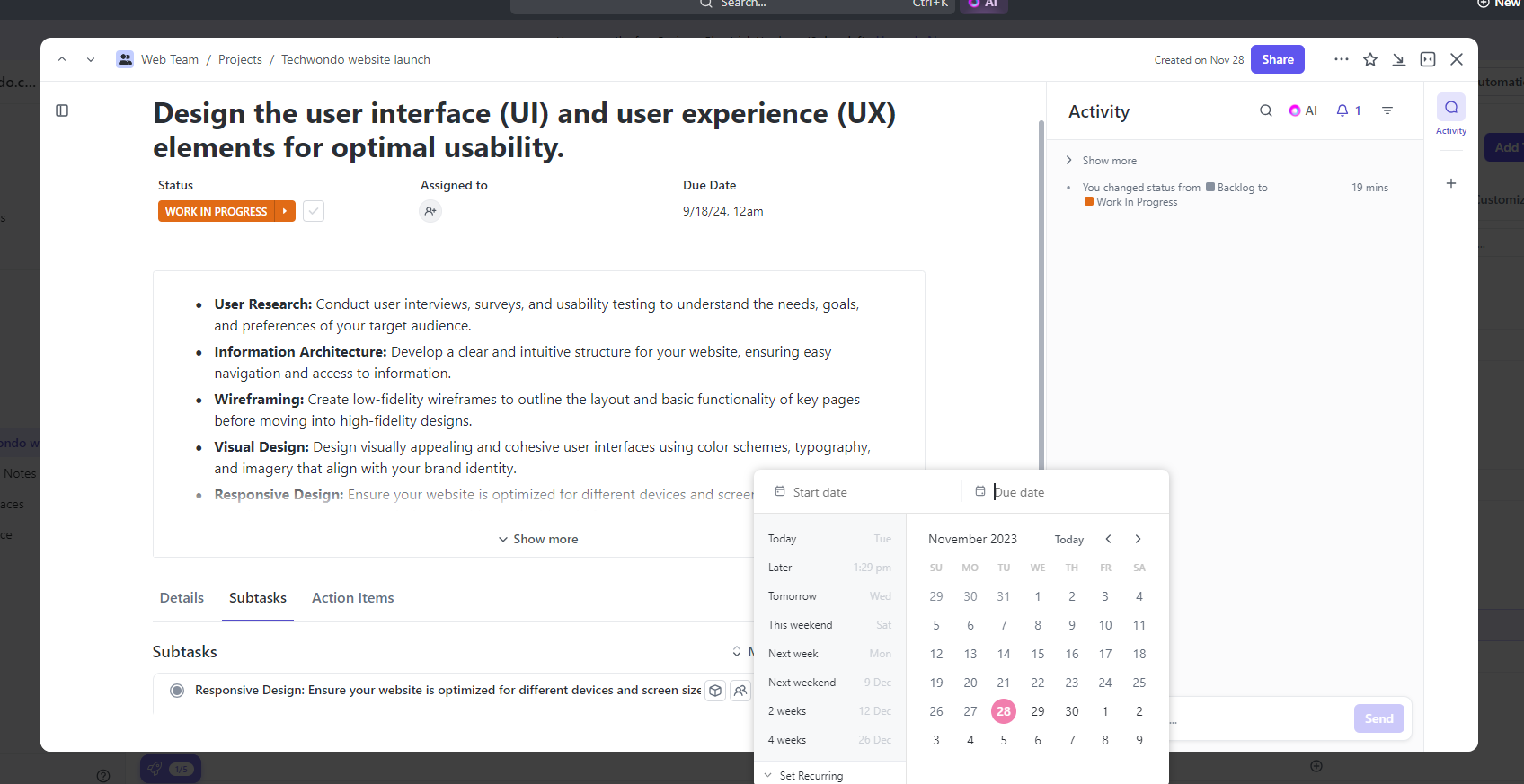
Adding a due date to a sub-task in ClickUp. Image: Tech.co’s Testing Process.
Like its rival Wrike, ClickUp provides all the basics needed to visualize the progression of your tasks, including a Gantt chart and Kanban board. There are also 13 additional views, giving you the freedom to find one that works for you – a privilege you won’t have when using Basecamp. ClickUp’s spreadsheet view supports formulas, although the “Team view” isn’t available on the free plan.
Users will be able to track the time it takes to complete tasks with a time-tracking feature, and you can attach comments to tasks that require feedback or input from multiple team members. ClickUp has one of the most comprehensive resource management tools on the market. It can provide a comparative overview of each team member’s resources, including month-by-month and week-by-week breakdowns. You’ll also get a Gantt-style view of each of your team member’s assigned tasks.
ClickUp pricing
ClickUp offers a free plan and three paid plans. The Unlimited plan costs $7 per user, per month when billed annually and is highly capable considering its price – it’s a lot more powerful than Smartsheet’s Pro plan, which costs the same.
ClickUp’s Business plan costs $12 per user, per month, while the Enterprise plan – which is only really suitable for very large businesses – doesn’t have public pricing available at present. Check out our ClickUp pricing page for more information.
Who is ClickUp best for?
With its robust feature set and abundance of great collaboration tools, ClickUp is the best overall task management platform that we’ve come across.
In particular, it’s a great solution for larger businesses that depend on extensive cross-team collaboration. A business that sells point-of-sale solutions, for instance, will need input from product managers, marketers, designers, sales agents, and backend engineers, when it comes to bringing a new feature to market. With ClickUp, these disciplines can collaborate quickly and effectively, using ClickUp Chat to facilitate the process, the online whiteboard to work together in real-time, and permissions and guest access to segment different tasks by stakeholder.
Wrike
Price From: $10 per user, per month
Best for: Large businesses
Task management score: 4.7/5
Wrike scores the same as ClickUp for task management – but it’s not quite as good in other areas and doesn’t offer that many task management features on its free and first paid plan, so comes in second place on this list. However, it does have a great range of integrations and two plans geared towards large businesses.

Pros
- No-nonsense, robust feature catalog
- Lots of customizability
- Strong task management and data tools
- Huge integrations library
Cons
- Not entirely easy to use
- Difficult to use automation builder
- Not the best for collaboration
All of the project views in Wrike are really easy to navigate between, and the platform will auto-populate them all with the information you initially input into your first view.
Essential task management tools and features, such as a Gantt chart, a calendar, a milestones function, and custom fields are included in the Team plan and upwards.
The free plan is missing a few things – such as the calendar – but it’s got no user limit and would still suit a small team that needs somewhere to track their day-to-day work. A resource management tool and time-tracking feature, on the other hand, is reserved for Business plan customers with larger teams.
When I tested Wrike, I found the setup to be really smooth – there was a lot of guidance provided which meant that by the time I was eventually let loose on the software myself, a lot of the things I needed to set up were already set up. It scored 4.1/5 on our most recent ease-of-use tests, which is a slight improvement on its previous result for this assessment area and a better score than ClickUp. The layout is very similar to Asana’s and Teamwork’s, and it’s not hard to get to grips with.
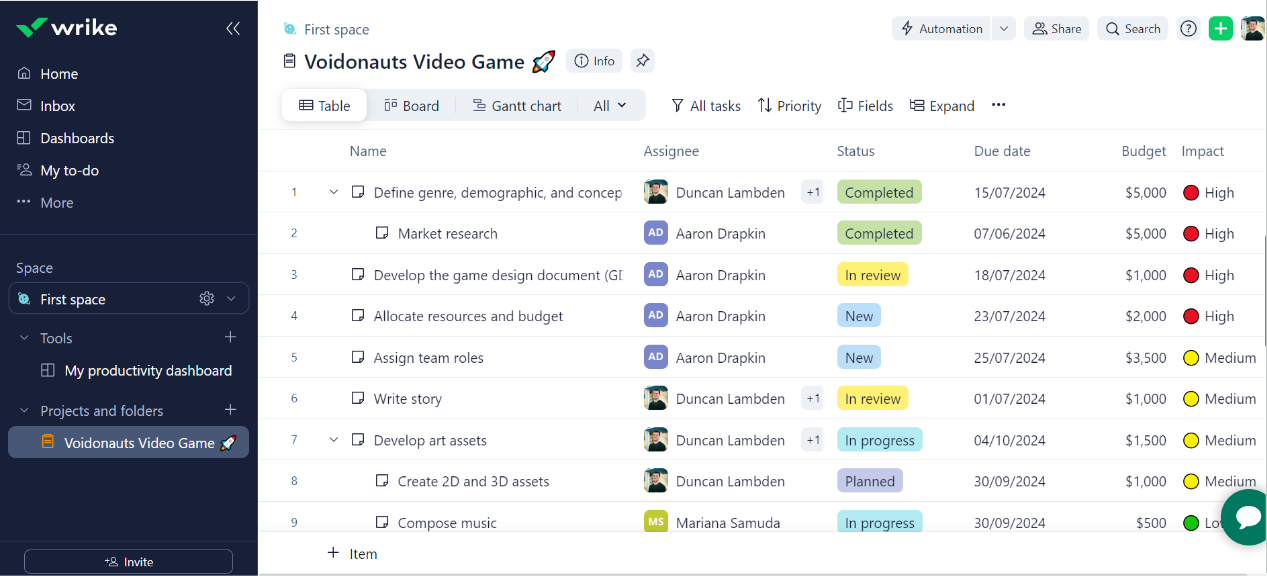
Wrike’s Table view. Image: Tech.co’s Testing Process.
Like ClickUp and monday.com, Wrike has AI capabilities that can help you automate many of your task management processes – and it’s available on all plans. Wrike’s AI text tool can provide AI-based task prioritization recommendations, turn unstructured text into action items, voice notes into actions and proactively identify project risks based on historical data.
Wrike pricing
Like ClickUp, Wrike has a free plan, but it’s quite limited and doesn’t include task management features like a Gantt chart task dependencies, or a calendar view.
The Team plan is available for $10 per user, per month, which is more expensive than monday.com’s and ClickUp’s first paid plans. Strangely, although the free plan is unlimited, there’s a user limit of 15 on this plan.
Wrike Business plan costs $24.80 per user, per month and includes the provider’s full suite of task management tools. Wrike has two plans without public pricing – the Enterprise plan and the Pinnacle plan – which have advanced security features geared toward large businesses such as “Locked spaces”. Head over to our Wrike pricing page for more information.
Who is Wrike best for?
Over the course of our evaluation, we concluded that Wrike was the best platform for large companies and organizations. It’s also an excellent solution for organizations that need the capacity to quickly scale up their operations. For instance, a tech startup, which can be known to rapidly expand at short notice, will savor the ability to build a huge library of custom tasks. With this, you can build a bespoke workspace to suit your team needs, whatever they may be.
monday.com
Price from: $9 per user, per month
Best for: Ease of use
Task management score: 4.5/5
monday.com is the easiest-to-use task management tool we’ve tested, utilizing a minimalistic layout that’s significantly less intimidating than the raft of features that appear on your screen when you log into Wrike and ClickUp.

Pros
- Highly customizable platform
- Custom fields feature available on all plans (including the free plan)
- Rule-based automation can be used to complete simple tasks, like archiving items
Cons
- Free plan has 2-person user limit
- Limited third party integrations
- Higher tiers required for basic features
Despite not looking complicated, monday.com has a range of task management features, including a spreadsheet that supports conditional formatting on all plans, and a custom fields function for storing different types of data there isn’t a dedicated field for already.
monday.com’s Kanban board was one of my favorites to use – it was really straightforward to drag cards around, which could be edited at the click of a button. Again, the inviting and unintimidating layout made the task-editing process significantly less stressful.
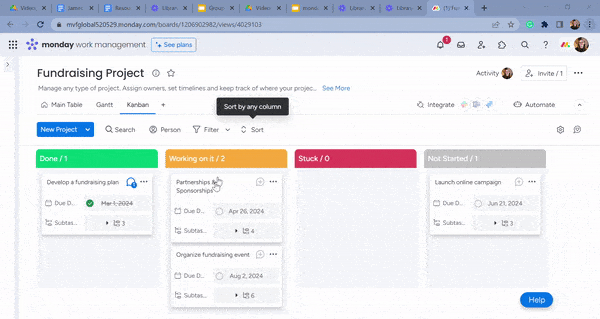
Using monday.com’s Kanban board. Image: Tech.co’s Testing Process.
monday.com has a more capable task commenting feature than most competitors and will let you tag users in comments as well as assign users to comments (Teamwork will only let you do the first of these two actions). This is really useful to have if you’re expecting a lot of back on forth on tasks between team members, like you might while implementing a content strategy for a website.
monday.com pricing
monday.com has five plans, which is one more than both Wrike and ClickUp. There’s a free plan that has a decent range of task management tools but a user limit of two, so it won’t be suitable for your team if it’s larger than that.
The Basic projects plan is available for $9 per user, per month, but in terms of task management tools, it’s just as limited as the free plan – there’s a Kanban board but no Gantt chart, calendar view, or task dependencies.
The Standard Projects plan is just $2 more expensive, retailing at $12 per user, per month, and for that little bit extra you’ll have access to a calendar view, a milestones function, and a Gantt chart.
The Pro Projects plan ($19 per user, per month) adds in a task dependencies function and a time-tracking feature so you can plan better with regard to how long tasks may actually take. monday.com also has an Enterprise plan (custom pricing) which is the only plan with onboarding assistance available.
While it may be more expensive than some of its competitors, it’s important to bear in mind that monday.com regularly rolls out updates to optimize its service. For example, in August 2024, the platform introduced functionality to allow users to enable or disable weekend days from their task management, save their in-progress forms as drafts, and export canvases to print-ready PDFs.
Who is monday.com best for?
Owing to its simplicity and intuitive interface, we concluded that monday.com was the easiest platform to use. It would be a great option for smaller businesses that don’t have time to upskill on a new project management tool. For example, it would be particularly valuable for a wine bar and retailer that wants to take its operations online.
As a customer service organization, they would probably need quite a wide-ranging set of features, including distribution management, staff management, and more. With its quick setup time and easy-to-use interface, monday.com is a great way to save time, meaning they can spend more time serving customers and less time finessing their IT skills.

Creating a task dependency in monday.com. Image: Tech.co’s Testing Process.
Teamwork
Price From: $10.99 per user, per month
Best Task Management Software: Value for money
Task Management Score: 4.3/5
Teamwork came second overall in our last round of project management testing, and joint third when it comes to task management, scoring the same as Asana.

Pros
- Lots of collaboration tools
- Kanban-style boards and Gantt charts available
- Affordable pricing and solid free option
- Great security options
Cons
- Limited built-in integrations
- Data visualization isn't the easiest
Teamwork is our best value task management plan because almost all of its task management tools are available on its free plan and $10.99 per user, per month Starter plan. This is quite different from monday.com and Wrike, who lock away some task management tools on their more expensive plans.
Teamwork will let you manage intricate tasks without paying a penny, and although it might not have brought out an AI tool to assist you, that is unlikely to concern those on a tight budget. Most importantly, all the basics are covered – there are sub-tasks and task dependencies to help with the finer details, and a sufficient number of views are offered up for keeping track of the progress of your project.
Along with solid task management options, Teamwork provides an excellent automation builder, which you’ll enjoy using if you feel like you’re always bogged down by little administrative tasks that have to be done throughout your day. Along with its wide range of preset project templates, this helped teamwork to a 4.2/5 for workflow creation, second only to ClickUp.
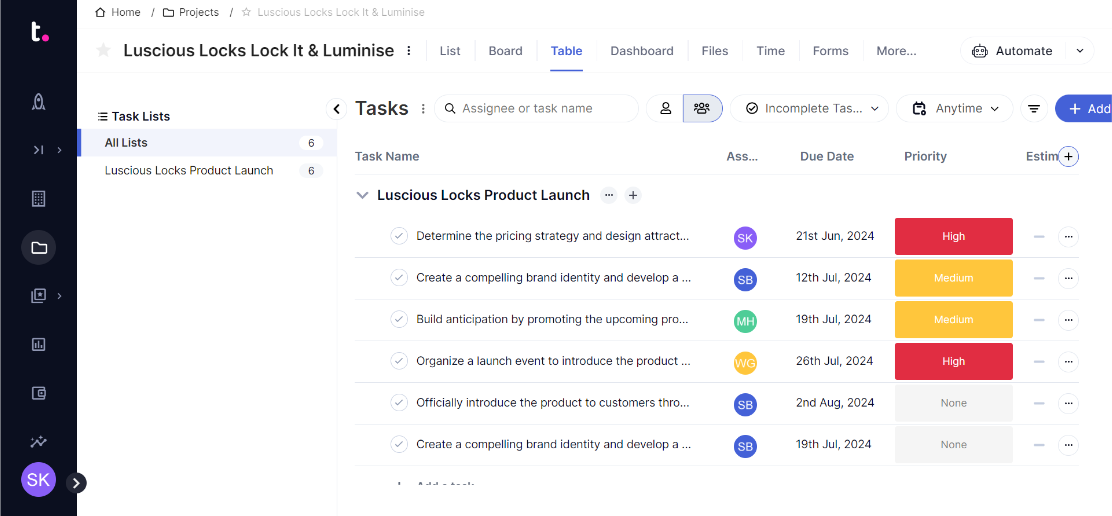
Teamwork’s Table view. Image: Tech.co’s Testing Process.
Like Wrike, when I tested Teamwork, I found the onboarding really helpful and assuring – it set me up for success from the word go, leaving nothing to chance.
Teamwork is a really easy-to-use platform, and it actually came second on our ease-of-use tests (4.3/5), beaten only by monday.com. The only downside to Teamwork is that it limits the number of custom fields you can create – there’s a limit of two on the free and first paid plan and a limit of three on the Grow plan.
Teamwork pricing
Teamwork is the best value provider on this list, with a highly capable free plan with a 5-person limit. Despite this low user cap, it offers more task management tools than any other free plan other than ClickUp’s – including a Gantt chart and custom fields.
The Deliver ($10.99 per user, per month) and the Grow ($19.99 per user, per month) plans might have similar offerings when it comes to task management.
Who is Teamwork best for?
Teamwork is our pick of good value task management platforms. It has a lot to offer the sole traders or freelancers that don’t want to spend a dime on their project management solution. As we’ve mentioned, its free plan is really good, with custom fields that will come in handy for a freelance copywriter with several different clients and projects on the go.
Asana
Price from: $10.99 per user, per month
Best for: Tracking budgets and displaying project data
Task Management Score: 4.3/5
Asana is one of the most widely task management tools in the world, with at least 139,000 paying customers.

Pros
- Unlimited storage
- Plenty of third-party integrations
- Incredible clean and intuitive interface
- Easy to use dashboards and chart builder
Cons
- Most key features require a Premium plan
- Very high prices for larger teams
- No phone-based support
Asana offers a raft of useful task management features, including classic project views (Gantt, Kanban, etc.) and all the task management fundamentals, such as task dependencies. You’ll also be able to attach files and documents to tasks, comment on them, and add tasks to multiple projects.
Asana is one of your best options if you want to track the budgets of individual tasks – Teamwork only lets you do this on its most expensive plans, and although monday.com offers this as an option, I found it much, much trickier than I did in Asana.
Asana is a really easy-to-use program and scored 4.2/5 on our ease-of-use tests, meaning it’s not far off monday.com and Teamwork. Although I found the interface looks a little cluttered when you open up a task to edit it, it’s all pretty intuitive – especially compared to the likes of Jira.

Creating a custom field in Asana. Image: Tech.co’s testing process.
Like Wrike and monday.com, Asana has been working on an AI assistant that can make task prioritization recommendations and an AI text tool that can turn unstructured text into actions. However, this hasn’t been released just yet, so you’ll have to wait a little longer to find out how it actually functions.
Asana pricing
Asana has four plans, including a basic free plan, but as we’ve covered, it doesn’t have many features – milestones, task dependencies, a Gantt chart and custom fields aren’t included. It also has a user limit of 15 so it definitely isn’t suitable for teams larger than that.
The paid plans offered by Asana are quite expensive – the first paid plan costs $10.99 per user, per month, almost double the price of Teamwork’s first paid plan. However, it does add the features listed above missing from the free plan.
The Business plan costs $24.99 per user, per month, and this is the first plan with time-tracking and resource management features.
There are two Enterprise plans with no public pricing, but they offer virtually the same collection of task management features as the Business plan. Enterprise+ features everything that can be found in the Enterprise plan, as well as an in-built audit log, security information and event management (SIEM) integration support, and more. For more information, visit our Asana pricing guide.
Who is Asana best for?
Asana is our top pick for businesses that need to track budgets and display project data. Users can make use of several different varieties of chart to suit their needs, track their spending on a project with a line chart, and track progress of each task with a donut chart. Sales and marketing teams that operate a marketing funnel will find a lot of value in this level of insight and visualization.
Key Features to Look for in Task Management Software
Although most task and project management tools offer a wide range of features, there are some core ones you should be on the lookout for because they provide essential functionality. Here are a few to keep in mind:
Project views
The different “Views” provided by task management software providers like monday.com will help you understand how the different tasks that make up your project slot together.
For example, a Kanban board, which is provided by all the top project management software brands, focuses on the status of your tasks. They could be “in progress”, “completed” or “blocked”. Gantt charts, on the other hand, show tasks displayed against time.
Tools like ClickUp also provide over 15 project views, including a “List” view, which is just a simple board showing a list of your project tasks and the most straightforward way to see what you have to complete.

Setting a task duration time in ClickUp. Image: Tech.co’s testing process.
Most project management tools also offer a calendar view and a spreadsheet-style view, as well as a “team view”, which lets you see tasks organized by the team members assigned to them.
Sub-tasks
Sub-tasks are a key component of granular task management, and they’re exactly how they sound. They’re the smaller, secondary tasks that every larger, core task in your project will be made up of.
For example, if you’re building a website, one of your tasks may be “Design a Website Logo” – but this might be broken up into sub-tasks such as “background research”, “competitor analysis” and “submit designs to graphics team”.
Sub-tasks ensure you’re not forced to oversimplify tasks just to input them into your project management software or deal with an unmanageably large task list.
Time-tracking
Task management software tools that have a time-tracking feature, such as Asana and Teamwork, will let you track how long tasks are taking to complete. If you’re trying to improve the efficiency of your team, this can be an important metric to have.
Some time-tracking tools will also let you attach time estimates for specific tasks, which can help with mid-project planning. Others, such as the one included in monday.com, will let you add billing amounts to time spent on tasks.
AI work assistance
As you’re probably aware, since the rise of ChatGPT, businesses have been finding inventive ways to use AI to save themselves time with increasing frequency – and more and more companies have started to build AI capabilities into their software.
Task management software tools monday.com and ClickUp both have AI assistants – monday.com’s is currently in Beta and is gradually released to the platform’s users, while ClickUp’s costs $5 per workspace per month.
ClickUp’s AI tool will soon be able to autogenerate tasks and sub-tasks, while monday.com’s can already do this as well as summarize and rephrase documents and text.
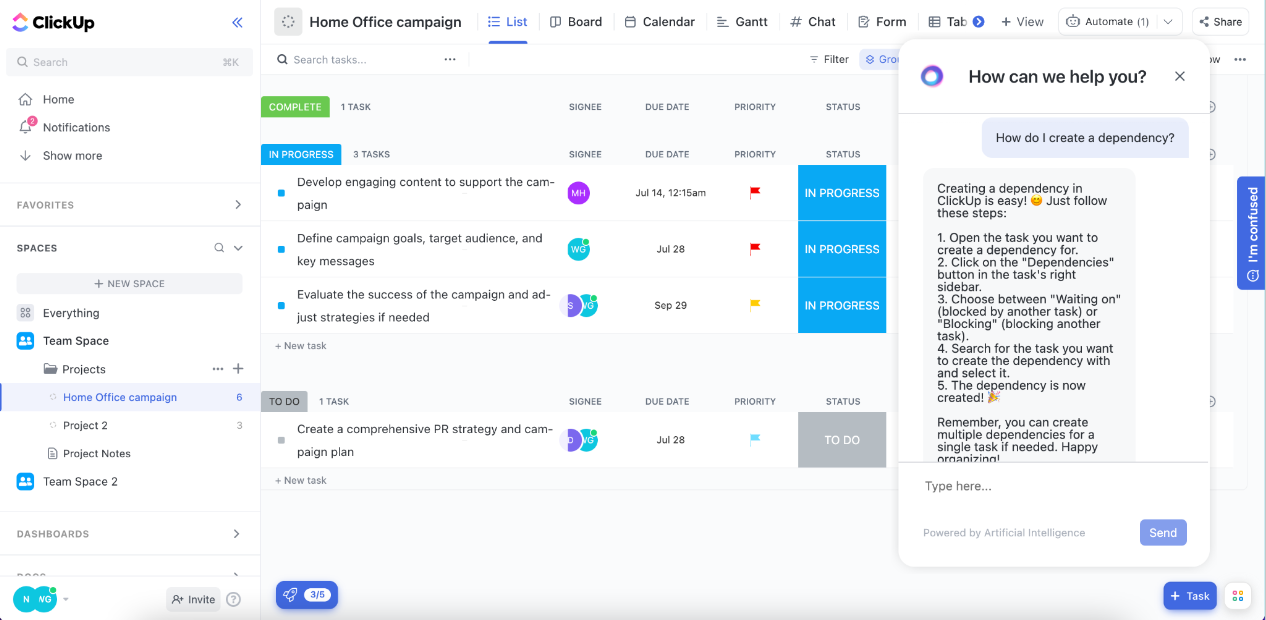
ClickUp’s list view with AI chatbot. Image: Tech.co’s Testing process.
Custom fields
Project and task management software tools have a variety of different “fields” that allow you to input different types of information. For example, there might be a field in your list view that lets you input the status of a task – another may before for the task assignee.
However, custom fields are fields where you can input any information you want,.They come in handy when your task management software doesn’t have a dedicated field for a specific type of information, such as budget data.
About Our Research
At Tech.co, we conduct research into all of the products, services, and software we write about. This includes extensive market research to scout out the major players in every vertical we cover, and instigating conversations with businesses that have to make difficult buying decisions every day in the name of improving efficiency, organization, and their top line. Everything we learn from this work is then fed into our unique user testing criteria.
To find out what the best task management software tool is, our research team naturally focused on providers that offer a selection of fundamental features that are required to manage tasks effectively, and how easy they are to use. This became one aspect of a broader series of project management software and Work OS platform tests, as these are the tools that are the most effective at task management.
During the testing series, we focused on six different areas: Security, Integrations, Pricing, Customer Support, Functionality, and Ease of Use. “Functionality” is broken down into four subsequent assessment areas: task management, data visualization, workflow creation, and collaboration.
Although we have commercial partnerships with some of the providers we write about, this never impacts how we rank products, services, and software that appear on our site. In fact, it’s our research that allows us to remain editorially independent.
Verdict: Why ClickUp is the Best Task Management Software
ClickUp is the best task management software we’ve tested, scoring higher than 9 other providers including monday.com and Teamwork. There are more than 15 different ways to view your projects and enough that can bring a real sense of clarity to your most complex tasks. Importantly, ClickUp also has a wide range of collaboration and data display tools, plus a custom automation builder, also available on all of its plans. That’s why it narrowly beat Wrike, which also scores 4.7/5 for task management.
Wrike’s Business plan ($24.90 per user, per month) is just as capable when it comes to complex task management as ClickUp’s counterpart, but Wrike locks away features like time tracking and a resource management tool on this plan, rather than providing them for you at a cheaper price – so it’ll be a more attractive proposition if you’re part of a large business with a considerable software budget.
If ease of use is your priority, however, monday.com will be your top choice for task management software. Much like Wrike, the key difference between monday.com and ClickUp is that some of monday.com’s task management features are only available if you pay for the Standard or Pro projects plan, which are both more than $12 per user, per month.





